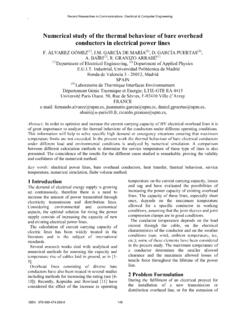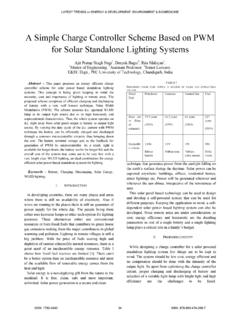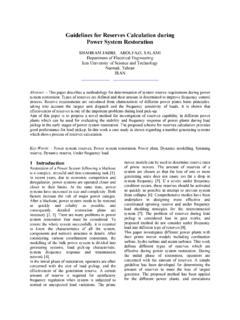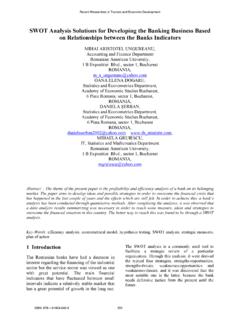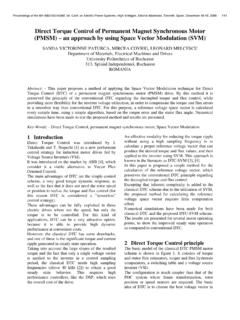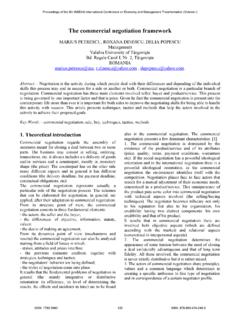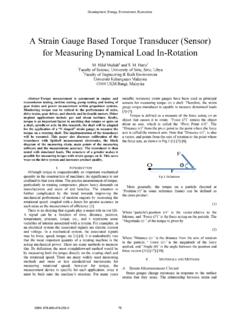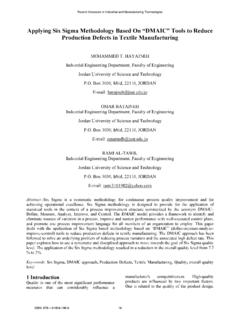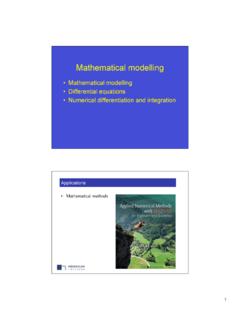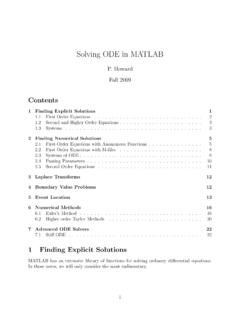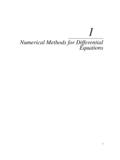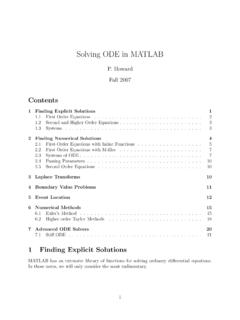Transcription of MATLAB program for Simulation and Control of the ...
1 Abstract The paper shows advantages of the computer technology for the Simulation of the technological system s behaviour and Control . The technological process here is represented by the Continuous Stirred Tank Reactor (CSTR) as a typical member of a nonlinear lumped-parameters system widely used in the industry. The computer Simulation has great importance nowadays with the decreasing value of the computer components together with the growing computer speed. The adaptive Control used here fulfils all basic Control requirements and it can be used for the systems with nonlinear behaviour. The benefit of this paper can be found in the Simulation program made in mathematical software MATLAB with the use of Graphical User Interface (GUI) that provides user possibilities to examine simulations without changing of the program code.
2 Keywords MATLAB , modeling, Simulation , adaptive Control , recursive identification. I. INTRODUCTION HE most of processes in the real world, not only in the industry has nonlinear behaviour. On the other hand, chemical reactors belong to the most often equipments in the chemical and biochemical industry and that is why this paper is focused on one particular member of this family the Continuous Stirred Tank Reactor (CSTR) with exothermic reaction inside. Specific design of the controller is usually precede by few very important steps. Not every property of the controlled system is known before we start and that is why we perform Simulation experiments on the system. There are two main types of the investigating of the system s behaviour (1) experiment on the real model and (2) computer Simulation .
3 Computer Simulation is very often used at present as it has many advantages over an experiment on a real system, which is not feasible and can be dangerous, or time and money demanding. Simulation and modelling possibilities rise with the increasing impact of the digital technology and especially with the Manuscript received May 12, 2011. J. Vojtesek is with Department of Process Controll, Faculty of Applied Informatics, Tomas Bata University in Zlin, Czech Republic (phone: +420576035199; fax: +420576032716; e-mail: vojtesek@ ). P. Dostal is with Department of Process Controll, Faculty of Applied Informatics, Tomas Bata University in Zlin, Czech Republic (e-mail: dostalp@ ). computer technology which grows exponentially every moment.
4 The mathematical model of this particular CSTR is described by the set of two nonlinear Ordinary Differential Equations (ODEs) which are constructed with the use of material and heat balances inside. Examples for deriving such mathematical models can be found in [1]. The steady-state analysis investigates behaviour of the system in the steady-state which from the mathematical point of view means numerical solving of the set of nonlinear algebraic methods. The simple iteration method [2] was used in this case because the system fulfills the convergence condition. The next step is the dynamic analysis which practically means numerical solving of the nonlinear set of ODEs. A lot of numerical solution methods have been developed, especially for the ODE, such as Euler s method or Taylor s method [3].
5 Runge-Kutta s methods are very popular because of their simplicity and easy programmability [4]. The basic idea of adaptive Control is that parameters or the structure of the controller are adapted to parameters of the controlled plant according to the selected criterion [5]. The adaptive approach in this work is based on choosing an external linear model (ELM) of the original nonlinear system whose parameters are recursively identified during the Control . Parameters of the resulted continuous controller are recomputed in every step from the estimated parameters of the ELM. The polynomial method introduced by Kucera [6] used for designing of the controller here together with the pole-placement method ensures basic Control requirements such as stability, reference signal tracking and disturbance attenuation.
6 The basic Control system configurations with one degree-of-freedom (1 DOF) and two degrees-of-freedom have been used. The proposed controller is hybrid because polynomial synthesis is made for continuous-time but recursive identification runs on the -model, which belongs to the class of discrete-time models. The MATLAB (MATrix LABoratory) is mathematical software often used for computation and Simulation [7]. Although this software has it own programming language, it also provides the tool for creating window-like programs which can be used for testing and Simulation without changing of the program and knowledge about this programming language. This tool called GUIDE was used here for creating of the Simulation program as a practical output of this contribution.
7 This program is available for free. If you are interested, please contact author on his email address MATLAB program for Simulation and Control of the Continuous Stirred Tank Reactor Jiri Vojtesek, Petr Dostal T Recent Researches in Circuits, Systems and Signal ProcessingISBN: 978-1-61804-017-645 II. MODEL OF THE PLANT The proposed Control strategy was tested on the mathematical model of Continuous Stirred Tank Reactor (CSTR). This model has simple exothermic reaction inside the tank which is cooled via cooling coil see Fig. 1. Mathematically speaking, this plant is represented by the mathematical model which describes all quantities is of course very complex and we need to introduce some simplifications. First, we expect that reactant is perfectly mixed. Then, we also assume that volume, heat capacities and densities do not change rapidly during the Control .
8 Fig. 1 The schematic representation of CSTR These assumptions results in the mathematical model represented by the set of two Ordinary Differential Equations (ODE) [8] which are derived from the material and heat balances of the reactant and cooling, i. e. ()()()41021301011caqAccAAAAdTaTTak caqeTTdtdcacck cdt = + + = (1) where a1-4 are constants computed as 1234;;;cpcappcpcchqHaaaaVccVc ==== (2) The fixed values of the system are shown in Table 1. TABLE 1. FIXED PARAMETERS OF THE REACTOR Quantity Symbol and value Reactor s volume Reaction rate constant Activation energy to R Reactant s feed temperature Inlet coolant temperature Reaction heat Specific heat of the reactant Specific heat of the cooling Density of the reactant Density of the cooling Feed concentration Heat transfer coefficient V = 100 l k0 = 1010 min-1 E/R = 1 104 K T0 = 350 K Tc0 = 350 K H = -2 105 cp = 1 cpc = 1 = 1 103 c = 1 103 cA0 = 1 ha = 7 105 The nonlinearity of the model is hidden mainly in the computation of the reaction rate, k1, which is nonlinear function of the temperature, T, and it is computed from Arrhenius law: 10eER Tkk = (3) III.
9 STEADY-STATE AND DYNAMIC ANALYSES The pre- Control Simulation often includes steady state and dynamic analyses which help us with the understanding, how system works in different states and behaves after various changes on the input. A. Steady-state Analysis The steady-state analysis shows behaviour of the system in the steady-state, in t and results in optimal working point in the sense of maximal effectiveness and concentration yield. Mathematical meaning of the steady-state is that derivatives with respect to time variable are equal to zero, d( )/dt = 0. The previous studies [9] have shown interesting steady-state feature of this reactor. It is clear, that the reactant and cooling heat must be equal in the steady-state, Qr = Qc, which means that the equation (1) in steady-state is rewritten to: ()()410213010caqAccaTTak caqeTT + + = (4) and results in relations for these heats Qr and Qc: 44211310311ccsrAaaqqscccQak cQaaqeTa Taqe= =+ + (5) If we compute Qr and Qc for various values of the temperature T = <300, 500> K for working point q = 100 and qc = 80 , we obtain three steady-states see Fig.
10 2. 300350400450500-1000100200300S2N1Qr(T),Q c(T) ( )Ts (K) Qr QcS1 Fig. 2 Heat balance inside the reactor As you can clearly see, this system has two stable steady-states (S1 and S2) and one unstable steady state (N1). The steady-state values of the state variables in these points are: 111112 lNTKcmol lSTKcmol l ====== (6) It is clear, that the second operating point S2 has better efficiency ( % reacts) for the same input settings than on the point S1 ( % reacts). Recent Researches in Circuits, Systems and Signal ProcessingISBN: 978-1-61804-017-646 So the steady-state model is finally described by the set of nonlinear functions 4410213013101111ccaqsAcsaqcsAAa Ta k ca q TeTaa qea ccak + + = + =+ (7) which are easily solved numerically by the simple iteration method.

